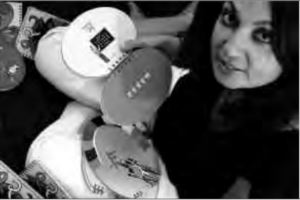 Coonoor Kripalani is Honorary Research Fellow at the Centre of Asian Studies (CAS), the University of Hong Kong. She wrote her thesis on a comparison of Gandhi and Mao and maintains a keen interest in current developments in India, China, and Southeast Asia. Currently based in Singapore, she conducts research and writes on popular Hindi film, as well as radio broadcasting in India. Her articles on films include topics such as terrorism, in-film advertising, and marriage and family. In addition to her work on film, Kripalani has developed a series of four Hindi books for preschool children, and bilingual editions were published in 2007 by the Global Indian Foundation (Singapore). In the interview that follows, Kripalani provides readers with both a good introduction to Indian film and specific information about the changing tastes of Indian youth.
Coonoor Kripalani is Honorary Research Fellow at the Centre of Asian Studies (CAS), the University of Hong Kong. She wrote her thesis on a comparison of Gandhi and Mao and maintains a keen interest in current developments in India, China, and Southeast Asia. Currently based in Singapore, she conducts research and writes on popular Hindi film, as well as radio broadcasting in India. Her articles on films include topics such as terrorism, in-film advertising, and marriage and family. In addition to her work on film, Kripalani has developed a series of four Hindi books for preschool children, and bilingual editions were published in 2007 by the Global Indian Foundation (Singapore). In the interview that follows, Kripalani provides readers with both a good introduction to Indian film and specific information about the changing tastes of Indian youth.
Lucien: Thank you for this interview, Coonoor. Readers have enjoyed your articles on Indian films in past issues of EAA. Would you please briefly tell us a little about your background and how you became interested in cinema?
Coonoor Kripalani: I worked at the Centre of Asian Studies, University of Hong Kong for a number of years. My field is history, and while in Hong Kong, I wrote my Master’s of Philosophy thesis on a comparison of Gandhi and Mao.
Living overseas, I did not see a Hindi film for many years until the mid-1990s.
Then, quite by chance, I saw a film called Akele Hum, Akele Tum (Lonely Me, Lonely You, 1995), which addressed the dual careers of a couple, the resulting conflicts within their marriage, and the whole issue of separation and divorce. I was struck by the theme and maturity of the film, and amazed at how far popular Hindi film had come from its formulaic stereotype of the 1970s.
In the 1960s and 70s, popular Hindi film was viewed snobbishly by the elites and intellectuals as a form of mass entertainment—“low brow,” as Ashish Nandy phrased it. But in hindsight, we know that the creators of this very successful style of entertainment were highly talented and cultured elites themselves, who were in fact driven by ideology. A number of scriptwriters, directors, and actors were members of progressive associations. So it is no accident that films of these decades spoke for the downtrodden, depicting capitalists as evil and exploitative, in contrast to the common man or menial worker, who was shown to be honest and had upstanding values. Post-independent India was built on socialist ideology, with the rationalist and secular views associated with Nehru (India’s first Prime Minister), and popular Hindi film of these years reflected these values.
Seeing Hindi films after a long gap brought to my attention the differences in contemporary films vis-à-vis those of earlier decades. I was also interested in studying the popular appeal of this “low-brow” entertainment—what was it that made them so successful? Lucien: I know that film is popular in India, and over the last decade more Americans at least have heard of Bollywood. Please share with our readers what you know about Bollywood’s beginnings, how you think it is distinctive from the cinema of other nations, and what changes you have seen over time in India’s film industry.
Lucien: I know that film is popular in India, and over the last decade more Americans at least have heard of Bollywood. Please share with our readers what you know about Bollywood’s beginnings, how you think it is distinctive from the cinema of other nations, and what changes you have seen over time in India’s film industry.
Coonoor Kripalani: Film as a form of entertainment has a long history in India. Moving images were introduced into India six months after the first screening of the Lumiere Brothers Cinematographé in Paris in December 1895. The earliest Indian filmmaker was Dadasaheb Phalke, who made Raja Harishchandra in 1913. He inspired others like Baburao Painter, Damle, and Fathelal. The advent of talkies made it an even more popular medium, and because of its wide reach and potential as a propaganda tool, film was subjected to censorship by the British administration. Films in the early part of the twentieth century were mainly mythological, or they addressed social ills such as women’s and caste issues. Fantasy films, such as the enormously popular and wondrous Hunterwali films, featured Fearless Nadia (a Caucasian stunt actress, who played a sort of super-woman in scant clothes with the ability to fight tough guys) from the studios of the Wadia (J.B.H. and Homi) Brothers. These three studios and their directors were able to transition successfully from silent films to talkies.
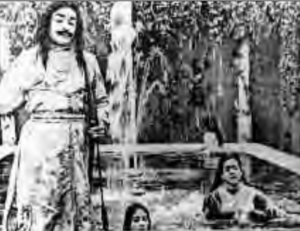
Image source: www.filmnirvana.com.
The first Indian talkie, Alam-Ara (The Light of the World, Ardeshir Irani, 1931), set the template for future Hindi film. Taking advantage of sound, the film was almost a musical, with lots of song and music. This remains a feature of all Bollywood movies— directors know that they must have at least a couple of “hit numbers” if their films are not to flop. There is no such genre as a “musical” in Bollywood film, but there are films without songs.
The films of the 1950s were inspired. They were the output of groups of very talented and ideologically inclined writers, directors, and actors. Encouraged by India’s newly acquired independence, and with a zeal to reform society from within, people like Raj Kapoor and K.A. Abbas, the scriptwriter for some of Kapoor’s films (Guru Dutt and Mehboob Khan), gave audiences cinema that championed the underdog, identified the common man with Indian values, and juxtaposed the have-nots and haves in a simplistic equation of good against evil.
By the late 1960s and in the 1970s, films turned formulaic: boy meets girl, they fall in love, their love faces obstacles that they overcome, and love triumphs. Together with romance, Hindi films also depicted the angry young man who faced discrimination, lacked job opportunities, and was a victim of both official corruption and underworld gangsterism. Amitabh Bachchan epitomized these roles, playing the sometimes violent, but always upright, hero. He became the most popular star of this period.
Still, the intellectual elites rejected these films for their pandering to mass appeal. Following the lead of Satyajit Ray (Pather Panchali—Song of the Road, 1955), a select group of filmmakers began to make parallel cinema or art films. These films, without songs, deliberately showed realism, in contrast to the hip-swinging, costume-changing, location-shifting films for popular consumption. They took a hard look at contemporary issues. Actors in art or parallel cinema were generally theater actors, actors of conscience, or relative newcomers. Budgets for these films were generally very low, and many of them were made under the auspices of the National Film Development Corporation of India (NFDC).
With the advent of economic reform and a new prosperity in India, films gradually have begun to reflect the consumerist society—music, dress, and language with which the young generation can identify. Big-budget films with light romantic feel-good stories are back in fashion; action films and family dramas are big box-office hits. Themes have also become bolder. The new films are not afraid to discuss issues of urban life, such as living out of wedlock, surrogate motherhood, divorce, infidelity, winter-summer couples (with the woman being the winter), old age—themes that were considered un-Indian or too sensitive to be shown on-screen, or, as in the case of old age, unattractive to the box-office. Characters in contemporary film incorporate the Indian diaspora without vilifying the overseas character as was done in the past. Locations move realistically from country to country, and now many plots are closer to reality than fantasy, but the song and dance sequences continue. If anything, they are souped-up versions for the twenty-first century.
In popular Hindi film, song and dance sequences are the distinctive features, compared to Hollywood or European film. As contemporary film in India develops more sophisticated productions that widen appeal from its mass base to include other sectors of the population, the distinction between popular and parallel cinema is getting blurred. For instance, the film Taxi 9211 (2006), which is a Bollywood production, had two of the industry’s leading male stars, Nana Patekar and John Abraham, play opposite each other in roles that showed the life of a poor taxi driver and a spoiled-brat super-rich kid, and how their lives intersect. The main storyline was not interrupted by song and dance. The same is true of Khosla ka Ghosla (A House for Mr. Khosla, 2006) and Bheja Fry (Fried Brains, 2007).
Another departure from Hollywood and European films is the intense patriotism of popular Hindi film. Wars have inspired several films valorizing India’s men in uniform, while films like Lagaan (Once Upon a Time in India, 2001) and Chak de! India (Go for It, India, 2007), which have sports themes, swell national pride. Even a light-hearted film like Namaste London (2007) pits west against east, and stridently informs the viewer of the greatness of Indian culture and history.
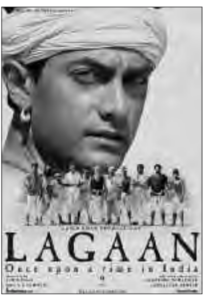
http://www.impawards.com/
2001/lagaan.html.
© 2001 Aamir Khan Productions.
Family dramas, particularly Kabhi Khushi Kabhie Gham (Sometimes Happiness, Sometimes Sadness, 2001) and Kal Ho Naa Ho (Tomorrow May or May Not Be, 2003), were hugely popular across the board with all generations. Their appeal to youth was due to the young, beautiful people who move seamlessly between Indian and Western locations, and Indian and Western dress. They drive fast, glitzy vehicles, use cell phones, and wear the latest fashions. Their homes are opulent and wealthy. But the final message upholds Indian family values, proclaiming in their subtext that these values are what ensure the happiness of individuals and safeguard the well-being of the community.
Many changes have occurred in India between the post-independence generation and their children. Assuming we classify youth as those aged under thirty-five years, this group is estimated to be between forty and fifty percent of India’s population. So of course, advertisers, educators, and the state target this demographic group. I call it the MTV generation, having been exposed to Western TV programs for most of their lives (satellite TV was allowed in India in 1992, on the heels of the reform liberalizing the economy). This group has never seen a war (apart from Kargil in 1999), and has mostly seen a rapidly growing economy that encouraged consumerism, and one that has opened up job opportunities. New sectors of industry, particularly the service industry, have provided jobs and mobility to many thousands of small-town youth who seek careers in the main cities.
Indian skies opened to many more airlines and routes, making overseas travel more accessible. Hotels, shopping malls, cinema multiplexes, and restaurants—all the features of a “modern” twenty-first century city—have begun to appear in many towns across India. Young people have credit cards, and they use them to shop for fashionable clothes, cars, mobile phones, and celebrations—sometimes to impress each other and give the spender a feeling of superiority. The spending power of youth in India is propelling them towards a consumerist society, reflected in the films they like to watch, films that are produced with the box-office in mind.
Lucien: In what ways do you think the desires and interests of Indian youth influence Bollywood, and how, in turn, do you think Bollywood influences Indian youth cultures?
Coonoor Kripalani: I’d like to identify five areas of difference between twenty-first century youth in India, and those of a generation before them: language, music, dress/fashion, body consciousness, and identity.
LANGUAGE: The previous generation had a great divide between the English educated elites and those who did not speak English. The distinction has blurred on both sides now—English educated youths, especially in Delhi and the Hindispeaking areas, might prefer to speak in Hindi with their peers, punctuated by phrases like “browse the web” or “hit the icon.” These same phrases are known equally to Hindi speaking youths, who also punctuate their spoken Hindi with the same terms.
There is an ease with which they speak, confident that their language is “cool” and “hip.” This is the language of Bollywood film as well. A young actor is more likely to say “red car” on film, than use its common Hindi term, “laal gaarhi.” English slang like “wow” and “hi” are commonplace, and “You’re so cute” seemingly does not have as cute a Hindi equivalent. So it would seem, everyone speaks a little English mixed in with Hindi.
Colloquial Hindi from the Mumbai area (which is not part of the Hindi belt) has its own peculiarities—a language that has been popularized by Hindi film. The dialogue of Lage Raho Munna Bhai (Carry On, Munna Bhai), the 2006 blockbuster, is replete with this Mumbaiya. Mixed with Marathi and Gujarati words, and street slang, phrases like “apun bola . . .” (I said . . .), “phoket mein” (for no reason) and the coarse “uski waat lag gayee” (he’s in big trouble), would normally be incomprehensible to the Hindi-speaker. Although this type of phraseology has appeared in Hindi film for years, now it’s the language of the “kool kid.”
MUSIC: The music that youth enjoy is like the language they speak—a fusion or hybrid. Hindi or Punjabi rap (similar to some types of folk music) is played routinely at clubs in India and around the globe. It is the music of Bollywood, which has historically been recording Hindi lyrics to Western tunes, supported by an orchestra composed of Western and Indian instruments. The rights to remix the now famous-again Roy Orbison song, Pretty Woman (for the film Kal Ho Naa Ho), were apparently purchased for US $7 million. Done by the master musician, A. R. Rahman, the remixed song, that combines bhangra beats and hip-hop, now played around the world, seems an Indian composition!
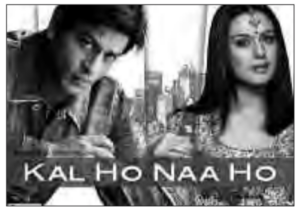
Image source: http://usman-786.tripod.com/shahrukh_preity
Bollywood music is catchy with rhythmic beats and is known throughout the world as good dance music. Youngsters today have no problem swaying to Bollywood beats, unlike their parents’ generation, whose discotheques played only Western rock and pop. For the latter, dancing to Hindi pop was unthinkable. Popular Hindi music has become popular among youth throughout the country, almost like a national unifier, cutting across class and community.
DRESS AND FASHION: Dress has been one of the areas most influenced by popular film. Historically, style trends have been set by popular actors and their on-screen clothes. Skimpy Western clothing on women was generally associated with the vamp, while the heroine would wear Indian clothes. Similarly, men wearing shirts unbuttoned with lots of gold chains round their necks could safely be assumed to be the bad guys. But this is no longer true. The distinctions have blurred and heroines routinely wear skimpy clothes (until they marry and become mothers onscreen), while heroes’ outfits might have the bad guy profile of yesteryears!
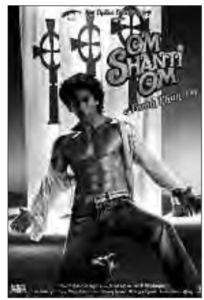
the film at http://omshantiom.
erosentertainment.com.
© Red Chillies.
Do real people actually dress like that? The answer is yes and no. In the larger metropolitan areas, young women might wear skimpy Western garb, but they have a sense of where to wear what. They would not, for instance, dress skimpily for the market, or walk about the streets. Between the film industry and the fashion industry, an indigenous fashion has developed that is at once “sexy” (but not so revealing) and traditional—sarees and salwar-kurtas, updated for the twenty-first century. Men are not left behind in this sartorial shift, and there are designers of fashion who specialize in Indian menswear with unique cuts and textured fabrics and embellishments that hark back to Mughal dress. These trends on-screen and off are creating a unique Indian fashion statement.
BODY CONSCIOUSNESS: Lean, toned, muscular bodies are in for young men as never before. The proverbial six-pack and rippling biceps are now almost requisite for any big star, e.g., Salman Khan (always had his shirt ripped off in fight scenes to show off his muscles). Shah Rukh Khan, probably the biggest male star today, has followed suite after many years, especially for his hit film, Om Shanti Om (2007) in which he showed his newly toned torso, and most recently, the heart-throb star John Abraham, on the cover of Filmfare (October 29, 2008), wears nothing but briefs. There is a great consciousness of the body, particularly among urban youth, and it is not unusual to see young men with built-up bodies. While the concept of body-building is not unknown in India—there were always the “pahalwans” (the strong ones) who developed their muscles for “kushti” (wrestling)—the idea of flagrantly displaying it is very new.
Young Indian women are also conscious of their bodies, and working out in gyms is common for the urban girl. Weight training, running, power yoga, hot yoga, Ashtanga yoga, Pilates, and dance are all popular with young women. Maintaining a lean, strong body is their aim, and once again, this silhouette is reinforced by popular film. No longer are heroines voluptuous like the stars of the 1950s, 60s, and 70s. They are lean and trim and slip just as easily into Western garb as they do Indian. Traditionally, stars playing the role of heroine did not show a lot of skin, and still not many do, but there are a growing number of female actors who do, notably Bipasha Basu, Malaika Arora, and Mallika Sherawat. While their fans are unlikely to expose themselves in the same way, these stars are model figures—lean and fit, yet curvy.
IDENTITY: Indian youth today are confident, aggressive, and brash. They are proud to be Indian, and do not feel “third-world” compared to their Western counterparts, as perhaps their parents did. Their feelings of pride are bolstered by their rich cultural traditions, coupled with India’s economic march toward a consumerist society. Employed in India in multi-nationals, call centers, large Indian corporations, and in the service and entertainment sectors, youth in India have greater spending power than previous generations. They are not afraid to live on credit. Materialism, frowned upon in previous generations, is now openly flaunted, and with the opening up of economic opportunity, young people are sure that their turn to get wealthy will come. The young Indian draws his or her strength from the viewpoint of the old song, Saare jahan se achcha, Hindustan hamara (Better than the rest of the world is our India). Indeed, this is a common ringtone on many young Indians’ cell phones.
The media, particularly popular film, reinforce this national identity. To return to the example of Namaste London, the hero is pushed to deliver a resounding rebuttal to an old Englishman, who keeps referring to India as the land of snake charmers. In his monologue, the young Indian talks of India’s past greatness, her contributions to the world in math, science, and philosophy, and her great tradition of respect for all. The soft background music is an orchestral Saare jahan se achcha . . . , also known as Taranae-Hindi (Anthem of the People of Hindustan) which peaks to a rousing crescendo as he completes his speech. As the Indians around him on-screen begin to applaud, so does the viewing audience!
Lucien: These days, how popular are foreign films in India, especially among India’s young people?
Coonoor Kripalani: On an average day, twice as many Hindi (and regional language films) play in cities like Delhi and Mumbai, than foreign (mainly American) films. Smaller towns and rural areas have even fewer foreign films. Action films like the James Bond, Mission Impossible, and The Bourne Identity series, and suspense films, do draw young audiences
- Kabhi Khushi Kabhie Gham (2001), directed by Karan Johar. Though melodramatic for American tastes, the viewer gets an idea of the type of drama that appeals to Indian audiences. It is also insightful regarding family structure and the kind of family values upheld as desirable.
- Bunty aur Babli (Bunty and Babli, 2005), directed by Shaad Ali. A modern-day Indian Bonnie and Clyde, this film gives voice to the dreams and aspirations of India’s small-town youth. It shows what is achievable and where the obstacles lie. It also depicts the consumerist desires of youth.
- Lage Raho Munna Bhai (2006), directed by Rajkumar Hirani. This is a comic take on what Mahatma Gandhi, the father of the nation, has come to mean to youth in India today. In the process, the film revives the nation’s collective memory on Gandhi, educates the audience about Gandhi, and generates a patriotic and community spirit.

